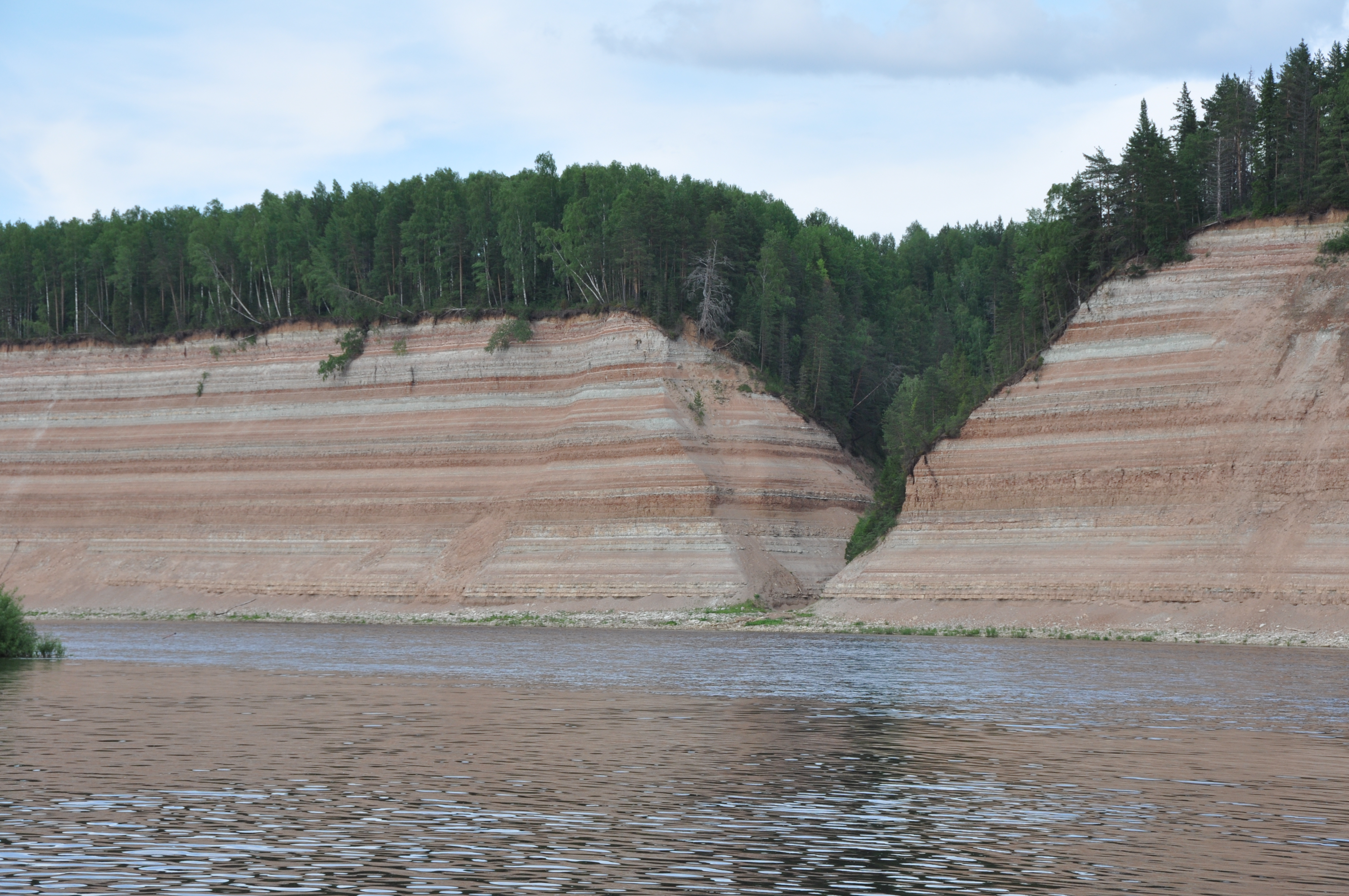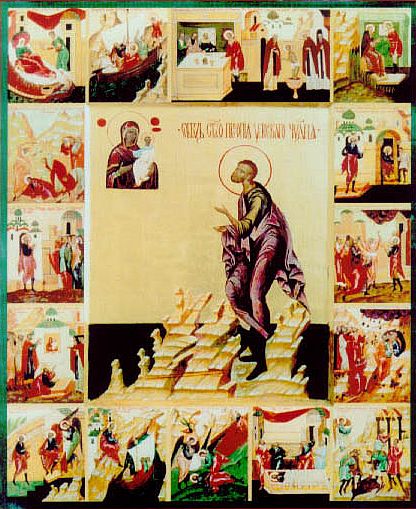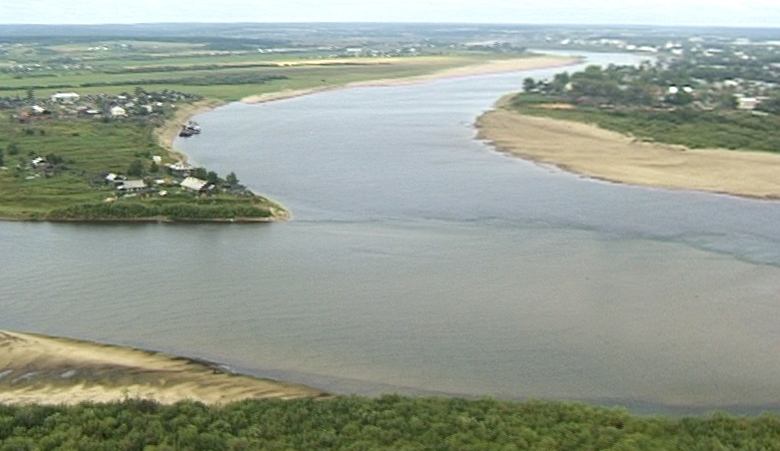|
Kuzino
Kuzino (russian: Кузино) is an urban locality (an urban-type settlement) under the administrative jurisdiction of the town of oblast significance of Veliky Ustyug, Vologda Oblast, Russia, located on the right bank of the Northern Dvina River at the confluence of the Sukhona and the Yug Rivers, opposite to Veliky Ustyug. Municipally, it is incorporated as Kuzino Urban Settlement, one of the three urban settlements in Velikoustyugsky Municipal District. Population: History In 1920s, Kuzino was part of Shemogodsky Selsoviet of Velikoustyugsky District of Northern Dvina Governorate. In 1930s, it grew up due to the construction of the mechanical works, and the nearby village of Yesiplevo was merged into Kuzino. In 1938, Kuzino was granted the status of an urban-type settlement. Economy Industry In the past, the main industrial enterprise in Kuzino was the mechanical works which went bankrupt and stopped operation in 2000s. Currently, the survived buildings of the works are ... [...More Info...] [...Related Items...] OR: [Wikipedia] [Google] [Baidu] |
Velikoustyugsky District
Velikoustyugsky District (russian: Великоу́стюгский райо́н) is an administrativeLaw #371-OZ and municipalLaw #1109-OZ district (raion), one of the twenty-six in Vologda Oblast, Russia. It is located in the northeast of the oblast and borders with Kotlassky District of Arkhangelsk Oblast in the north, Luzsky District of Kirov Oblast in the east, Podosinovsky District of Kirov Oblast in the southeast, Kichmengsko-Gorodetsky District in the south, Nyuksensky District in the west, and with Ustyansky District of Arkhangelsk Oblast in the northwest. The area of the district is . Its administrative center is the town of Veliky Ustyug (which is not administratively a part of the district). Population: 22,210 ( 2002 Census); Geography In Veliky Ustyug, the Sukhona and Yug Rivers form the Northern Dvina, one of the biggest rivers in Europe. Upstream from the town of Kotlas, and especially within the limits of the district, the Northern Dvina is sometimes referred ... [...More Info...] [...Related Items...] OR: [Wikipedia] [Google] [Baidu] |
Veliky Ustyug
Veliky Ustyug (russian: Вели́кий У́стюг) is a town in Vologda Oblast, Russia, located in the northeast of the oblast at the confluence of the Sukhona and Yug Rivers. As of the 2010 Census, its population was 31,665. Veliky Ustyug has a great historical significance and was one of the major cities of the Russian North. It preserved some of the past urban structure and many of the architectural monuments. It has lost its former leading role and is nowadays mostly known for tourism. Location and etymology Veliky Ustyug is close to the confluence of the Sukhona (flowing from the west) and the Yug (from the south) rivers. Downstream from this confluence the rivers form a single waterway known as the Northern Dvina, sometimes referred to as the Little Northern Dvina. The historical center of the town is on the left (high) bank of the Sukhona and, in contrast to many historical Russian towns, there is an embankment along the Sukhona. Dymkovskaya Sloboda and Troit ... [...More Info...] [...Related Items...] OR: [Wikipedia] [Google] [Baidu] |
Vologda Oblast
Vologda Oblast ( rus, Вологодская область, p=vəlɐˈɡotskəjə ˈobləsʲtʲ, r=Vologodskaya oblast, ) is a federal subject of Russia (an oblast). Its administrative center is Vologda. The Oblast has a population of 1,202,444 ( 2010 Census). The largest city is Cherepovets, the home of the Severstal metallurgical plant, the largest industrial enterprise in the oblast. Vologda Oblast is rich in historic monuments, such as the Kirillo-Belozersky Monastery, Ferapontov Monastery (a World Heritage Site) with the frescoes of Dionisius, medieval towns of Velikiy Ustyug and Belozersk, and baroque churches of Totma and Ustyuzhna. Large reserves of wood and fresh water are the main natural resources. History The area of Vologda Oblast was settled by Finnic peoples in prehistory, and most of the toponyms in the region are in fact Finnic. Vepsians, who still live in the west of the oblast, are the descendants of that population. Subsequently, the area was colonized ... [...More Info...] [...Related Items...] OR: [Wikipedia] [Google] [Baidu] |
Lalsk
Lalsk (russian: Лальск) is an urban locality (an urban-type settlement) in Luzsky District of Kirov Oblast, Russia, located northeast from Luza, the administrative center of the district. Population: History It takes its name from the Lala River, a tributary A tributary, or affluent, is a stream or river that flows into a larger stream or main stem (or parent) river or a lake. A tributary does not flow directly into a sea or ocean. Tributaries and the main stem river drain the surrounding drai ... of the Luza. The settlement was established by the Novgorodians fleeing east from Ivan the Terrible after the Massacre of Novgorod. It was a large trading outpost in the eastern part of the Russian North in the late 17th and 18th centuries. The earliest stone church was consecrated in 1711. Lalsk had town status between 1779 and 1927 and served as the administrative center of Lalsky District between 1924 and 1963. Architecture Lalsk is notable for a remarkabl ... [...More Info...] [...Related Items...] OR: [Wikipedia] [Google] [Baidu] |
Kirov Oblast
Kirov Oblast (russian: Ки́ровская о́бласть, ''Kirovskaya oblast'') is a federal subject of Russia (an oblast) in Eastern Europe. Its administrative center is the city of Kirov. Population: 1,341,312 ( 2010 Census). Geography Natural resources The basis of the natural resources are forest (mostly conifers), phosphate rock, peat, furs, water and land resources. There are widespread deposits of peat and non-metallic minerals: limestone, marl, clay, sand and gravel, as well as the extremely rare mineral volkonskoite. In recent decades, in the east of the area revealed a minor recoverable oil reserves and deposits of bentonite clays. In the area is the largest in Europe Vyatsko-Kama deposit of phosphate rock. The area is rich in mineral springs and therapeutic mud. On the territory of Kumyonsky District is famous resort town of federal significance Nizhneivkino, which on treatment and rest come to residents of the Kirov region and many regions of Russia. Hydrogra ... [...More Info...] [...Related Items...] OR: [Wikipedia] [Google] [Baidu] |
Luza, Luzsky District, Kirov Oblast
Luza (russian: Лу́за) is a town and the administrative center of Luzsky District in Kirov Oblast, Russia, located on the Luza River ( Yug's tributary), northwest of Kirov, the administrative center of the oblast. Population: History Luza was established as a settlement at the railway station in the end of the 19th century on location of an older settlement, which had been known since the 17th century. Town status was granted to it in 1944. Administrative and municipal status Within the framework of administrative divisions, Luza serves as the administrative center of Luzsky District.Law #203-ZO As an administrative division, it is, together with thirty-six rural localities, incorporated within Luzsky District as the Town of Luza. As a municipal division, the Town of Luza is incorporated within Luzsky Municipal District as Luzskoye Urban Settlement.Law #284-ZO Economy Luza is a large timber-works center. There is a sawmill and a railroad tie A railroad tie, ... [...More Info...] [...Related Items...] OR: [Wikipedia] [Google] [Baidu] |
Vologda
Vologda ( rus, Вологда, p=ˈvoləɡdə) is a types of inhabited localities in Russia, city and the administrative center of Vologda Oblast, Russia, located on the river Vologda (river), Vologda within the watershed of the Northern Dvina. Population: The city serves as a major transport hub of the Northwestern Federal District, Northwest of Russia. The Ministry of Culture (Russia), Ministry of Culture of the Russian Federation has classified Vologda as a historic city, one of 41 in Russia and one of only three in Vologda Oblast. 224 buildings in Vologda have been officially recognized as cultural heritage monuments. History Foundation The official founding year of Vologda is 1147,Official website of Vologda Oblast Government: A brief history of Vologda ... [...More Info...] [...Related Items...] OR: [Wikipedia] [Google] [Baidu] |
Yesiplevo
Yesiplevo (russian: Есиплево) is a rural locality (a selo) and the administrative center of Yesiplevskoye Rural Settlement, Kolchuginsky District, Vladimir Oblast Vladimir Oblast (russian: Влади́мирская о́бласть, ''Vladimirskaya oblast'') is a federal subjects of Russia, federal subject of Russia (an oblast). Its closest border 66 Meter, km east of central Moscow, the administrative cen ..., Russia. The population was 458 in 2010. There are 14 streets. Geography Yesiplevo is located on the Ilmovka River, 15 km east of Kolchugino (the district's administrative centre) by road. Sloboda is the nearest rural locality. References Rural localities in Kolchuginsky District {{Kolchuginsky-geo-stub ... [...More Info...] [...Related Items...] OR: [Wikipedia] [Google] [Baidu] |
Northern Dvina Governorate
Northern Dvina Governorate (russian: Северо-Двинская губерния, ''Severo-Dvinskaya guberniya'') was a governorate ('' guberniya'') of the Russian Soviet Federative Socialist Republic from 1918 to 1929. Its seat was in the city of Veliky Ustyug. The governorate was located in the North of European Russia, and its territory is currently divided between Arkhangelsk, Vologda, Kostroma, and Kirov Oblasts and the Komi Republic. The name of the governorate originates from the Northern Dvina River. History The governorate was established on July 24, 1918 by the People's Commissariat for Internal Affairs of the Russian Soviet Federative Socialist Republic. The territory of the governorate was formed from five uyezds which were previously a part of Vologda Governorate (the uyezd centers are given in parentheses) *Nikolsky Uyezd (Nikolsk); *Solvychegodsky Uyezd (Solvychegodsk); *Ust-Sysolsky Uyezd ( Ust-Sysolsk); * Velikoustyuzhsky Uyezd (Veliky Ustyug); *Yarensky Uyezd ... [...More Info...] [...Related Items...] OR: [Wikipedia] [Google] [Baidu] |
Yug River
The Yug (russian: Юг) is a river in Kichmengsko-Gorodetsky, Nikolsky, and Velikoustyugsky Districts of Vologda Oblast and in Podosinovsky District of Kirov Oblast in Russia. It is long, and the area of its basin is . The Yug joins the Sukhona near the town of Veliky Ustyug, forming the Northern Dvina, one of the biggest rivers of European Russia. The principal tributaries of the Yug are the Sharzhenga (left), the Kichmenga (left), the Yontala (right), the Pushma (right), and the Luza (right). Most of the course of the Yug runs through the Northern Ridge, and the Yug is one of the biggest rivers crossing the ridge. The name of the river is identical to the Russian word for "south", but has Finno-Ugric origins and originates from the Komi word ''ju'', which means "water". It is cognate with ''joki'' "river" in the most river names in Finland and further with Oka, Vuoksi, Vakh, Yogan, etc. in Russia. The towns of Veliky Ustyug and Nikolsk, as well as the district ce ... [...More Info...] [...Related Items...] OR: [Wikipedia] [Google] [Baidu] |
Subdivisions Of Russia
Russia is divided into several types and levels of subdivisions. Federal subjects Since 30 September 2022, the Russian Federation has consisted of eighty-nine federal subjects that are constituent members of the Federation.Constitution, Article 65 However, six of these federal subjects—the Republic of Crimea, the Donetsk People's Republic, the Russian occupation of Kherson Oblast, Kherson Oblast, the Luhansk People's Republic, Lugansk People's Republic, the federal cities of Russia, federal city of Sevastopol and the Russian occupation of Zaporizhzhia Oblast, Zaporozhye Oblast—are internationally recognized as part of Ukraine. All federal subjects are of equal federal rights in the sense that they have equal representation—two delegates each—in the Federation Council of Russia, Federation Council (upper house of the Federal Assembly of Russia, Federal Assembly). They do, however, differ in the degree of autonomous area, autonomy they enjoy. De jure, there are 6&n ... [...More Info...] [...Related Items...] OR: [Wikipedia] [Google] [Baidu] |
Sukhona River
The Sukhona (russian: Су́хона) is a river in the European part of Russia, a tributary of the Northern Dvina. The course of the Sukhona lies in Ust-Kubinsky, Sokolsky, Mezhdurechensky, Totemsky, Tarnogsky, Nyuksensky, and Velikoustyugsky Districts of Vologda Oblast in Russia. It is long, and the area of its basin . The Sukhona joins the Yug near the town of Veliky Ustyug, forming the Northern Dvina, one of the biggest rivers of European Russia. The biggest tributaries of the Sukhona are the Vologda (right), the Lezha (right), the Pelshma (left), the Dvinitsa (left), the Tolshma (right), the Tsaryova (left), the Uftyuga (left), and the Gorodishna (right). Etymology According to the Max Vasmer's Etymological Dictionary, the name of the river originates from the Russian and most likely means "a river with a dry (hard) bottom". Physical geography The river basin of the Sukhona comprises vast areas in the central and eastern parts of Vologda Oblast, in the south ... [...More Info...] [...Related Items...] OR: [Wikipedia] [Google] [Baidu] |




